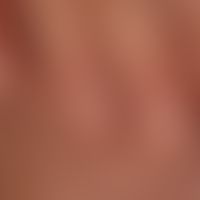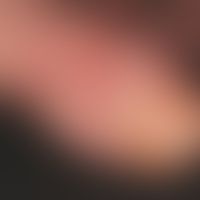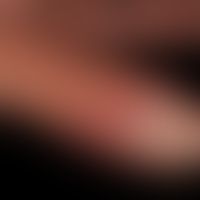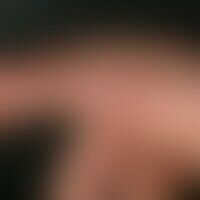Image diagnoses for "Finger"
108 results with 251 images
Results forFinger

Mixed connective tissue disease M35.10
Mixed connective tissue disease. hyperkeratoticnail folds with elongated capillaries and focal haemorrhages. Note the splatter-like scars on the back of the fingers as well as the expression of focal, now healed scarred, cutaneous vascular occlusions.

Nontuberculous Mycobacterioses (overview) A31.9
Mycobacteriosis atypical: chronic verrucous, blurred, painless, scaly plaque. aquarium owner.

Nontuberculous Mycobacterioses (overview) A31.9
Mycobacteriosis atypical: chronic verrucous, blurred, painless, scaly plaque. aquarium owner.

Nontuberculous Mycobacterioses (overview) A31.9
Mycobacteriosis atypical: Findings after 3 months of antibiotic therapy.

Nontuberculous Mycobacterioses (overview) A31.9
Mycobacteriosis atypical: a blurred, painless lump that has existed for 12 weeks and developed from an "inconspicuous" papule.

Hamartoma eccrines D23.L

Neurofibromatosis (overview) Q85.0
Type I Neurofibromatosis, peripheral type or classic cutaneous form. Permanent, multiple, skin-coloured, calotte-like bulging, soft, smooth papules and nodules in the area of the back of the hand and the sides of the fingers. Positive bell-button phenomenon: subcutaneous tumours protruding like hernia through the skin can be pushed back with one finger.

Panaritium L03.1
Panaritium, which developed in an HIV-infected patient approximately 3 months after a previously successful antiretroviral therapy with the protease inhibitor indinavir.

Candida paronychia B37.23

Candida paronychia B37.23

Pityriasis rubra pilaris (adult type) L44.0
Pityriasis rubra pilaris. Chronic, non-specific onychodystrophy. Complete loss of cuticle. Distal nail matrix thickened yellowish. Splinter hemorrhages.

Psoriasis palmaris et plantaris (overview) L40.3
Dry keratotic plaque type Chronically active, intermittent plaques, plaques and rhagades in a 48-year-old man, which have been present for more than 10 years, especially on the palm and fingers, multiple, rough, red, scaly, blurred and blurred spots, plaques and rhagades.

Raynaud's syndrome I73.0

Raynaud's syndrome I73.0

Rhagade R23.4
Rhagade. 75-year-old patient with a hyperkeratotic ?fingertip eczema? that has been present for years. Deep, extremely painful oblong substance defects that occur repeatedly at the same sites. No clinical signs of a local infection.

Swimming pool granuloma A31.1
Swimming pool granuloma. general view: For several months, continuously growing, completely painless redness and gradual plaque formation at the left forefinger base joint of a 60-year-old aquarium owner. 3 cm in diameter, red-livid, with central rhagade, painless, red knot at the base joint of the left forefinger covered with coarse scales.

Subungual verruca B07
Verrucae subunguales. digital wart bed with growth of the warts under the fingernail.

Verruca vulgaris B07
Verrucae vulgar. up to 0.6 cm in size, skin-coloured to whitish, chronic, rough papules and nodules with a verrucous surface in the area of the finger extensor sides. autoinoculation!

Verruca vulgaris B07
Verrucae vulgar. exophytic growing wart bed with subungual infiltration at the fingertip.

Verruca vulgaris B07
Verrucae vulgares (detailed picture): flat wart bed with subungual infiltration. This constellation results in considerable therapeutic complications. It is important to exclude a verrucous carcinoma.

Verruca vulgaris B07
Verrucae vulgares: multiple partly solitary, partly aggregated warts in a 16-year-old girl

Verruca vulgaris B07
Verrucae vulgares: solitary but also densely standing, to beds aggregated, hemispherical, 0.2-0.8 cm large, coarse, mostly skin-coloured or grey-yellowish papules or nodules with fissured, hyperkeratotic-verrucous surface.

Bowen's disease D04.9
Bowen's disease: sharply defined plaque that has existed for 2 years, interspersed with scales, crusts and erosions. Clear actinic damage to the skin of the back of the hand (therapy: 5% Imiquimod cream, 3 x per week under occlusion, complete healing).

